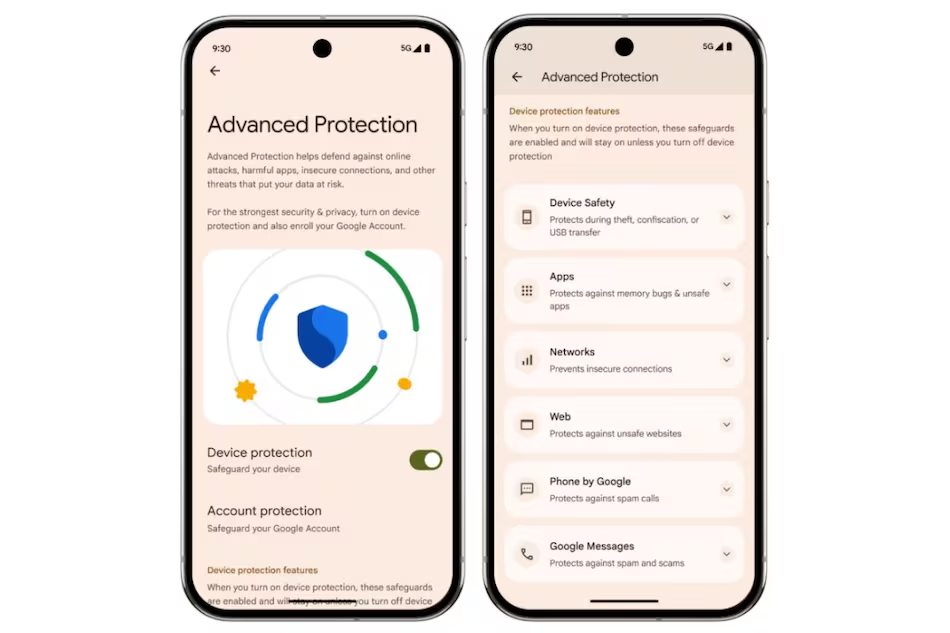Google Advanced Protection and Android 16 security features have taken mobile safety to the next level. With Android 16, Google introduces its most powerful built-in security suite ever—Advanced Protection. Once available only to high-risk users like journalists and activists, this robust feature is now accessible to everyone, bringing unmatched peace of mind to all Android users.
Unveiled during The Android Show on May 13—just ahead of the annual I/O Developer Conference—this marks a major upgrade in how Android devices handle security. In this article, you’ll learn what Google’s Advanced Protection is, how it works with Android 16, and why it’s vital for securing your digital life.

🔐 What is Google Advanced Protection?
Google Advanced Protection is a security program initially launched in 2017 for users who face greater cybersecurity risks. It includes several protective features aimed at preventing hacking, phishing, unauthorized access, and malware attacks.
Until now, this program required users to sign up separately and was mostly used by individuals in sensitive professions. With Android 16, however, Google has made it much easier—you can now turn it on directly from your device settings without needing any extra tools or installations.
This new integration makes Advanced Protection available to everyone, providing powerful defense against today’s growing cyber threats.
🚀 What’s New in Android 16 Security?
According to Il-Sung Lee, Android Security’s group product manager, Android 16 “enhances and expands the Advanced Protection features, making it simple to turn on an array of robust device security features.”
In simple words: you get stronger protection, and it’s much easier to use.
Once enabled, Advanced Protection acts as a single control point for your device’s most important security settings. It even extends protection to many Google apps like Chrome, Google Messages, and Phone by Google, with support for third-party apps expected in future updates.
🔒 Key Features of Advanced Protection in Android 16
Here’s a breakdown of the security features included in Advanced Protection:
1. Intrusion Logging (Coming Soon)
If your device gets compromised, this feature records logs of the suspicious activity. These logs are end-to-end encrypted and stored safely in the cloud for expert analysis. It’s automatically enabled when Advanced Protection is turned on.
2. Auto-Reconnect Blocker for Wi-Fi (Coming Soon)
This feature prevents your phone from automatically reconnecting to public or insecure Wi-Fi networks. It adds a much-needed layer of network safety.
3. Inactivity Reboot
Your device will automatically reboot if it stays locked for 72 hours. This can help remove malware or freeze unauthorized access attempts. This feature is enabled by default and cannot be disabled when Advanced Protection is on.
4. Google Play Protect
This well-known Android feature scans apps for malware and harmful software. With Advanced Protection, it stays on and cannot be turned off, ensuring consistent protection.
5. Android Safe Browsing
Helps protect you from visiting dangerous or phishing websites while using Chrome or other supported browsers.
6. Spam & Scam Protection (Messages)
Google Messages will filter and warn you about suspicious SMS or chat messages.
7. Caller ID & Spam Detection (Phone App)
You’ll be alerted about spam callers even before you answer the phone, helping avoid scams.
🧰 Other Advanced Security Features (All Enabled by Default)
These features can be turned on through Advanced Protection but cannot be turned off individually:
- Theft Detection Lock
- Offline Device Lock
- USB Protection (Coming Soon)
- 2G Network Protection
- Unknown App Blocking
- Memory Tagging Extension (MTE) – Prevents memory corruption by malicious apps
- Chrome Javascript Protection
- Scam Detection (Phone by Google)
- Automatic Call Screen
- Unsafe Link Warnings
⚠️ Some features like USB Protection and MTE may depend on the Android phone manufacturer, so availability might vary by device model.
📱 How to Enable Advanced Protection on Android 16
Advanced Protection is disabled by default. To enable it, follow these simple steps:
- Make sure your phone or tablet is running Android 16.
- Open the Settings app.
- Scroll to Google Settings.
- Tap Personal & Device Safety.
- Go to Advanced Protection.
- Toggle the Device Protection switch to ON.
Once activated, the protection is enforced at multiple levels—device, app, web, and network—ensuring a full “defense-in-depth” strategy.
👤 Who Should Use Advanced Protection?
While anyone can benefit from stronger security, Google recommends Advanced Protection especially for:
- Public figures
- Journalists
- Activists
- Corporate employees handling sensitive data
- Anyone worried about hacking or surveillance
Even if you’re an average user who just wants peace of mind, this feature is worth enabling.
✅ Final Thoughts: Why It Matters
In an age where cyber threats are growing more sophisticated, Android 16’s Advanced Protection is a much-needed step toward safer mobile experiences. It offers centralized, unbreakable security settings that protect your device, your apps, your online activity, and even your calls and messages.
By enabling Advanced Protection, you’re not just turning on a feature—you’re locking your digital front door with Google’s strongest key yet.